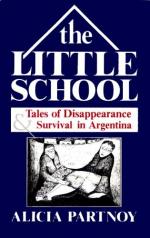|
This section contains 506 words (approx. 2 pages at 400 words per page) |

|
The Little School: Tales of Disappearance & Survival in Argentina Summary & Study Guide Description
The Little School: Tales of Disappearance & Survival in Argentina Summary & Study Guide includes comprehensive information and analysis to help you understand the book. This study guide contains the following sections:
This detailed literature summary also contains Topics for Discussion and a Free Quiz on The Little School: Tales of Disappearance & Survival in Argentina by Alicia Partnoy.
The Little School is an autobiographical account of life in an Argentine prison for political dissidents. Alicia Partnoy, the author, was kidnapped and held in one of these prisons, known as the "Little School" for several months. During that time, the prisoners were constantly forced to wear blindfolds, prevented from talking to or knowing about one another, or any of the prison staff. Prisoners at the Little School were brutally tortured on a regular basis, constantly humiliated and degraded by the guards and supervisors, starved, insulted and mocked. All of the prisoners had been "disappeared", taken from their families without any explanation of their fates, and many of them were killed.
Alicia Partnoy spent three months in the Little School and was placed in a state prison for two years thereafter. The account of her experiences in the book is partly fictionalized but contains a large measure of truth and real characters. Partnoy, a poet and professional writer, explains meaningful and terrible events in her time at the Little School through brief chapters that contains character and event sketches written in a quasi-lyrical fashion. Her descriptions of torture, repression and degradation are vivid and help to place the reader in the shoes of one whose rights have been denied and dignity destroyed simply for disagreeing with the policies of the Videlo/Massera/Agosti military junta where over thirty thousand people were "disappeared".
The story takes place between 1976 and 1977, during the first years of the military rule of Argentina following the deposition of Isabel Paron. Alicia had gotten involved in politics in college as a Peronist and socialist; the military junta arose to stop the country's movement towards socialism. The Peronists had a radical guerrilla wing whose violent actions against the military led to a repression campaign in which Partnoy and her husband were captured and taken from their young daughter, Ruth. The story begins with a description of the day Partnoy was kidnapped. While she was later released, escaping the Little School, many of her fellow prisoners were not. Partnoy's descriptions of them are all that remain.
The chapters are reconstructed from the little bits of information Partnoy could glean from what she could see through peepholes in her blindfold, from what she heard and from what she could smell and feel on her skin. She became focused on little things that helped her hold on to her humanity—storing pieces of bread under her pillow, feeling the rain on her body, the enjoyment of a rare used of a toothbrush, a small match box in which she keeps an acrylic tooth of hers, the chance on a single day to recite poetry to her fellow prisoners and other such incidents. The Little School is thus a tale of attempts to degrade human beings and their attempts to withstand it in any way they could.
The book also contains two appendices which list both all the information Partnoy can remember about her fellow prisoners and the guards at the Little School.
Read more from the Study Guide
|
This section contains 506 words (approx. 2 pages at 400 words per page) |

|



